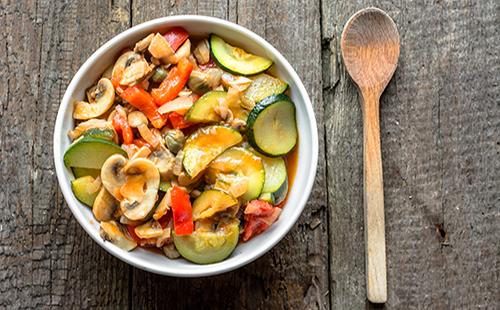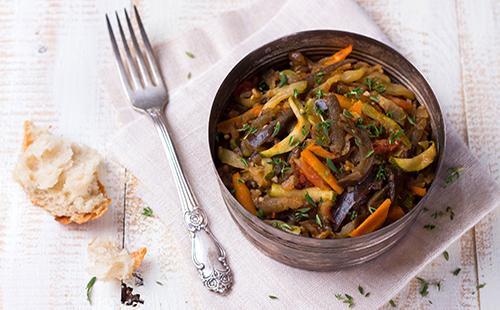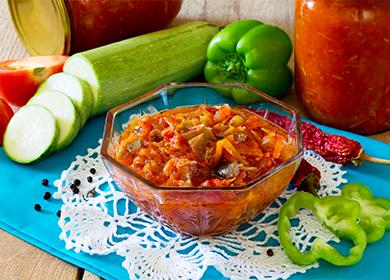A key characteristic of zucchini is its neutral taste. In the process of heat treatment, the vegetable is saturated with the aromas of other products and takes on completely new bright colors. Moreover, due to the zucchini, the volume of the finished dish increases significantly. And given the good yield and low cost of the vegetable during the harvest period, this is simply the perfect option for winter harvesting. Do not forget about the benefits that zucchini brings to the body:
- reduces the likelihood of neoplasms;
- relieves the symptoms of diseases of the male genitourinary system;
- strengthens the heart muscle and blood vessels;
- cleanses blood of cholesterol;
- normalizes intestinal motility;
- lowers blood pressure;
- normalizes the water-salt balance;
- strengthens the immune system;
- slows down the aging process;
- suppresses inflammatory processes in the body.
12 laws of delicious billets
Lecho is a fairly simple dish, which is prepared from familiar and understandable products. But there are some points, observing which you can turn an ordinary home preservation into a culinary masterpiece. Remember 12 rules and always follow them.
- Do not overdo it with spices. And tomatoes, and bell pepper, and onions are products with a fairly bright taste. It is important not to kill this aroma with a lot of spices. A mixture of ground peppers will be enough. For greater piquancy, you can add garlic and bay leaf.
- Put spices in each jar. When rolling the finished product into containers, make sure that both peppercorns and bay leaf fragments fall into each serving. Then, the contents of all the cans will be equally rich and spicy.
- Give preference to dry spices. They provide the longest storage. If you put fresh herbs in a dish, try to use it no later than six months later.
- Wash vegetables well. It is important to remove the smallest particles of earth and sand so that they do not crack on the teeth. If you buy vegetables in a store, wash them with a sponge and scald with boiling water to remove the remnants of the chemistry that processes the products.
- Add vinegar. It is not just a flavoring additive, but also an effective preservative. Citric acid has the same properties.
- Do not grind. The components of the lecho should feel good and vary in the finished dish.
- Start with the sauce. The longest process is the preparation of a tomato base. The remaining vegetables are added later. If you start cooking all the foods at once, they will become too soft and turn into porridge.
- Do not be afraid to experiment. There is no single recipe for lecho. You have the right to remove components from the recipe or add new ones at your discretion.
- Use the right utensils. The pan in which the lecho will cook must have thick walls. Due to this, vegetables will be cooked evenly.
- Sterilize the container thoroughly. Jars and lids should be washed well with soda. This is followed by mandatory steam or oven sterilization.
- Let the product stand. From the moment of preparation to the first tasting of the billet, at least three weeks should pass. If you open the jar earlier, the dish will seem fresh to you.
- Find the right place to store. Darkness and cold are what you need to sleep. In such conditions, the workpiece can stand up to two years. If you do not have a basement or a separate pantry, you can store cans at room temperature. But keep in mind that the shelf life of the product will be reduced to a year.
Product Selection Rules
Even if your choice fell on the simplest recipe for zucchini for the winter, the cooking process will require your skill and special knowledge. But still, the result will largely depend on the quality of the raw materials. The table contains recommendations for choosing key products.
Table - Product Selection Features
| Zucchini | Tomatoes | Pepper | Bow |
|---|---|---|---|
| - Young; - no more than 20 cm long; - with a thin and smooth skin; - uniform yellow-green or yellow-brown color; - without dark spots and mechanical damage; - with crispy flesh; - collected from May to July | - With a red-brown peel; - with a bright aroma; - with a green stalk or on a branch; - elastic; - juicy; - without spots, white veins and mechanical damage; - late grades | - Red or yellow; - with a thin, smooth, shiny skin; - without spots and mechanical damage; - with a green stalk; - medium size | - With a diameter of 3-5 cm; - tight; - with dry husk; - without spots and mechanical damage; - without green feathers; - with a dry tourniquet and root; - with a mild pleasant aroma |
Zucchini leche for the winter: 7 recipes for every taste
The principle of cooking squash lecho is not much different from the classic version. It should also contain such basic products as peppers, onions and tomatoes, the aromas of which are soaked in fresh zucchini. But, depending on in what proportion vegetables will be present, the taste will vary from soft-sweet to spicy-spicy. Choose the best recipe for yourself.
With onions
Features To please all family members, prepare homemade lecho from zucchini with onions for the winter. The taste is sweetish, which is especially liked by children. In addition, the composition does not contain hot spices, so such a meal will not cause heartburn.
You will need:
- 2 kg of squash;
- 1 kg of onion;
- 500 g of carrots;
- 1 liter of tomato juice;
- 50 g of sugar;
- the same amount of salt;
- 5 g of citric acid;
- white pepper.
Cooking
- Dice the zucchini. If they are large, be sure to remove the seeds and peel.
- Cut the onion into as thin half rings as possible.
- Grate the carrots.
- Lightly fry the carrots with onions. When they become transparent, put out under the lid for seven to ten minutes.
- Place tomato juice, vegetables, salt and pepper in a pan. Cook under the lid for seven to ten minutes.
- Add citric acid and sugar. Tomite another quarter hour.

With tomato paste
Features You will save a lot of time on preparing side dishes if you choose a recipe for lecho from zucchini with tomato paste. The finished product resembles a regular stew with a piquant note of bell pepper. This is a great addition to meat dishes.
You will need:
- 15 small zucchini;
- 500 g of tomato paste;
- ten bell peppers;
- head of garlic;
- 1.5 liters of water;
- 100 ml of vinegar;
- 60 g of sugar;
- 50 g of salt.
Cooking
- Mix the tomato paste with water and boil.
- Add oil and bulk components. Boil another ten minutes.
- Dice the bell pepper and finely chop the garlic. If you don’t like large pieces, rub the spice on a grater.Send the products to the tomato.
- After ten minutes, add the sliced zucchini to the boiling mixture.
- Rinse for ten minutes. Add vinegar and boil as much.
With bell pepper
Features Zucchini can not boast of outstanding taste. To fully reveal the taste palette, try cooking lecho with zucchini and pepper for the winter. A piquant sweetish vegetable will make its fresh “neighbor” flirt with new colors.
You will need:
- 3 kg of squash;
- 2 kg of bell pepper;
- 1 kg of onion;
- 1 liter of tomato juice;
- 100 ml of vinegar;
- 60 g of salt;
- as much sugar;
- 250 ml of vegetable oil;
- assorted peas.
Cooking
- Zucchini cut into half rings. The plate thickness should not exceed 3 mm.
- Cut the pepper into strips. Sauté it until transparent.
- Chop the onion rings.
- Pour tomato juice and oil into the pan. Add the onion here.
- When the mixture boils, add the bell pepper and cook for 20 minutes.
- Send zucchini, sugar, salt, vinegar and spices into the pan. After a quarter of an hour, the dish will be ready.

With eggplant
Features Fans of spicy tastes are simply obliged to cook lecho from zucchini and eggplant. Blue ones will make a familiar dish play in a new way. This lecho is the best suited to alcoholic drinks and aromatic barbecue. And it’s just delicious to eat with bread.
You will need:
- ten medium squash;
- as many bell peppers;
- eight small eggplants;
- 2 kg of tomatoes;
- 0.5 l of vegetable oil;
- 250 ml of vinegar;
- 400 g of sugar;
- 60 g of salt;
- five bay leaves;
- a teaspoon of coriander;
- ten peas of allspice.
Cooking
- Dice the eggplant and zucchini, and the peppers into strips.
- Blanch the tomatoes, peel them and pass through a meat grinder. You can just wipe them through a sieve.
- Pour the resulting tomato puree into a large enameled container. Add vinegar, vegetable oil, salt, sugar and spices. Boil the mixture.
- Send the vegetables to the tomato base and cook for 40 minutes.
With tomatoes
Features The recipe for lecho from zucchini with tomatoes for the winter is characterized by a large amount of sugar in the composition. The dish acquires a pleasant sweetness. Its taste is quite delicate, but at the same time spicy.
You will need:
- 3 kg of squash;
- 1 kg of tomatoes;
- 350 g of tomato paste;
- 1 kg of onion;
- 0.5 l of water;
- 250 ml of vegetable oil;
- 200 g of sugar;
- 100 ml of vinegar;
- 60 g of salt.
Cooking
- Slice the tomatoes and the main product into medium sized pieces.
- Cut the onion into half rings.
- Dilute the tomato paste with water. Boil the sauce.
- Add oil and bulk ingredients to the pan. Boil again.
- Send tomatoes and onions. Ten minutes later, put the squash.
- Pour vinegar into the mass and let it boil for about five more minutes.

No sterilization
Features If you want to keep a delicious crunch of vegetables, prepare lecho from zucchini without sterilization. This method does not imply long-term heat treatment, which allows to preserve the useful properties and texture of products as much as possible.
You will need:
- 2 kg of squash;
- 1 kg of tomatoes;
- as much bell pepper;
- 0.5 kg of onions;
- as many carrots;
- 100 ml of vinegar;
- 120 g of sugar;
- 50 g of salt;
- ground pepper mixture at your discretion.
Cooking
- Pure the tomatoes with a blender.
- Grate the carrots, chop the onions in half rings, and pepper - in strips.
- Lightly fry the onions and carrots.
- Boil tomato puree with loose ingredients.
- Boil the vegetables in the resulting sauce for ten minutes.
- Seven minutes after adding vinegar, the dish can be considered ready.
With rice
Features A rich flavored lecho goes well with dry, fresh rice. It will turn out a full nutritious dish. The blank will come to the rescue when there is no time or desire to stand at the stove.
You will need:
- 1 kg of zucchini;
- 2 kg of tomatoes;
- 500 g of carrots;
- as many onions;
- 250 ml of vegetable oil;
- as much water;
- 200 g of sugar;
- as much rice;
- 60 g of salt;
- two cloves of garlic.
Cooking:
- Poured and washed rice, fill with water two hours before cooking.
- Cut the tomatoes and zucchini into medium pieces, and the onion in half rings.
- Grate the carrots and squeeze the garlic.
- Stir all foods, including rice and water, and start heating.
- Half an hour after boiling, try rice. If it turns out to be hard, the dish will need to be cooked.
Geography of tastes
Lecho's popularity spread far beyond the borders of his native Hungary. In whatever country of the world this dish is prepared, everywhere the chefs strive to give it some kind of national shade. The table contains the most delicious options.
Table - What is added to lecho in different countries
| Option | What to add |
|---|---|
| Hungarian | - Instead of vegetable oil - melted lard; - paprika |
| In Bulgarian | - Apple vinegar; - clove |
| In Georgian | - Instead of garlic - grated horseradish; - chopped walnuts |
| In Italian | - Instead of fresh tomatoes - canned; - fresh basil |
| Bavarian | - Instead of tomato paste - spicy ketchup; - hunting sausages |
Does the dish harm the figure
Given that lecho has a vegetable base, it can be attributed to light dishes. 100 g of product contains about 30-50 kcal. But the presence of sugar increases the calorie content of the dish by at least 90 points. And the more sugar in the composition of the dish, the higher the risk of gaining extra pounds.
To enjoy the aromatic preparation all winter without fearing for a figure, it is recommended to reduce the amount of sugar or completely exclude it from the recipe. But in this case, you need to use fresh ripe tomatoes, which in themselves are quite sweet. But a tomato paste dish cannot be made without sugar, since it will turn out sour.
The first mention of zucchini associated with America. Residents of the country appreciated the taste and healthy qualities of the seeds, and the fruits themselves did not eat. In the XVI century, squash came to Europe. Residents of the Old World were struck by the beauty of the huge flowers of the vegetable. For almost 200 years, he adorned gardens and greenhouses. And only in the XVIII century the Italians appreciated the taste of the fruit. It is thanks to them that the inhabitants of the whole world learned about the nutritional properties of this vegetable. Today, hundreds of cooking options are known. Do not ignore the recipes lecho from zucchini for the winter.
Other salad recipes
Sun-dried tomatoes
Classic Caesar Sauce Recipe
Teriyaki sauce
How to cook beef

